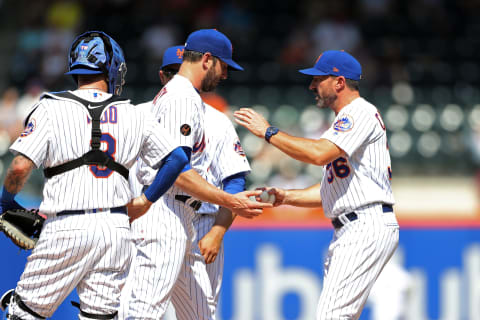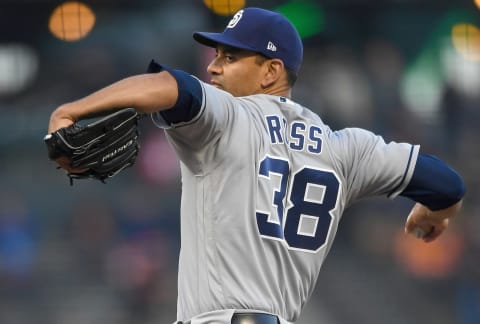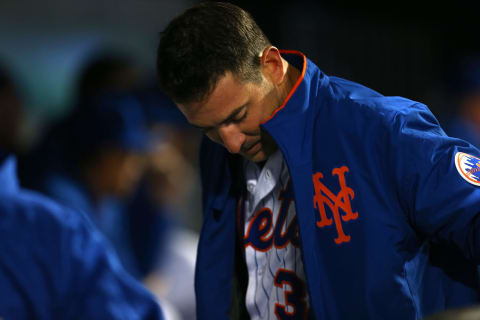Matt Harvey: New York Mets former pitcher worth a look?


Former New York Mets pitcher Matt Harvey has been DFA’d and will likely be granted free agency soon. Is the Dark Knight done for, or will we see a resurgence in another city?
After reports of New York Mets former ace Matt Harvey being seen partying in Los Angeles the night before a game in San Diego, the team DFA’d him. However, the right-handed starter has enough service time to refuse the assignment. If the team cannot find a trade partner within a week, he will become a free agent.
There are a number of teams that might make sense as a new home for him given his past success. But the question remains; is he worth the acquisition cost even if it’s just burning a 25-man roster spot?
His stats for this season aren’t pretty. A 7.00 ERA with a 5.69 FIP and a 2.22 K/BB certainly isn’t encouraging. His xFIP is a little better, but we when you are giving up quality contact often, that isn’t surprising.
The Dark Knight went only 5 IP in each of his first three starts. He then went 6 in his fourth and final game before being moved to the pen. That’s a 6.00 ERA with a .292 BA against in that role, so trying him as a reliever made sense.
Unfortunately, he was even worse after the demotion. The beleaguered pitcher posted a 10.50 ERA with an identical .292 BA and a whopping .452 wOBA. In short, he has been awful in 2018.
What went wrong?
Matt Harvey was one of the best young starters in the game when he came up in 2012, posting a 2.73 ERA. He struck out 28.6% of the batters he faced and walked 10.6%. In his first two full seasons, he maintained the impressive ERA and K% while bringing the BB% down under 5. His future was as bright as anyone in the game. So what happened? Thoracic Outlet Syndrome (TOS).
TOS is a condition in which the nerves, arteries or veins are compressed as they pass through the shoulder. This can be due to inflammation or a narrow passage around those conduits putting pressure on them.
It leads to anything from light tingling in the arm and hand to a significant loss of motor control or feeling. In some cases, left untreated, it can even lead to blood clots. For pitchers, even with treatment, the prognosis is not good.
For the most part, it has been a career killer with names like Josh Beckett, Daniel Bard, Luke Hochevar, and Phil Hughes all struggling to recover from it.

Is there hope?
Getting back to what he was before the diagnosis is likely not possible. Pitchers tend to lose velocity and command. And even after surgery (the removal of the top rib to ease pressure), it is rare to see pitchers resemble their former selves. Some have had a bit of success by reinventing themselves.
Tyson Ross’ numbers look an awful lot like the guy who broke out for the San Diego Padres a few years back, but his velocity is nothing like it was. He used to throw in the mid 90’s but is more of a low 90’s pitcher these days.
Jaime Garcia underwent surgery for TOS in 2014 and had a few useful seasons afterward. Though, his walk rate never really recovered and has deteriorated over the last three years. He is currently looking rather washed up. Mike Foltynewicz had multiple blot clots develop in his pitching arm due to TOS and while his results are as good as ever, his walk rate is also as high as it’s ever been. He doesn’t seem to have lost any velocity, however.
So the success stories are still weighed down by some negative data. This doesn’t bode well for our soon to be former Mets pitcher.
How does Matt Harvey appear to have been affected?
The news isn’t good for fans of the big righty. When stricken with the condition in 2016, his strikeout rate dropped to 18.9%, his lowest by a full six percentage points. It fell further to 15.6% last year and has remained in that vicinity this season.
His walk rate climbed from 4.9% in 2015 to 6.2% in 2016. Then it jumped to 10.6% last year before dropping back down to 7.3% this season. His stuff has taken a hit and his control was noticeably worsened by TOS.
Looking deeper there is an interesting dip in velocity, but not exactly where you would expect it given the timing of his diagnosis and surgery. Instead of the dropoff occurring right before he hit the DL in 2016, it appears to have happened in the middle of 2015. In that season he went from throwing 96-97 to around 95 MPH.
Symptoms of TOS can develop slowly and over a long period of time. Daniel Bard believes his symptoms started in late 2011 despite his diagnosis not coming until 2014. So the dip in 2015 could well be the first sign that Matt Harvey was suffering from TOS. Regardless, his velocity has never approached the upper 90’s since his surgery.
Beyond velocity, his hard hit percentage (at Baseball Savant) had gone from 30.7% to 36.7% between 2015 and 2016. This season it is up to 41.9%. He has also seen his average exit velocity against rise more than 3 percent since the 2015 season. And his barrel percentage against more than doubled. There aren’t any real signs that Matt Harvey can return to what he was before TOS took its toll on him.

And then there are the off the field issues.
More from Call to the Pen
- Philadelphia Phillies, ready for a stretch run, bomb St. Louis Cardinals
- Philadelphia Phillies: The 4 players on the franchise’s Mount Rushmore
- Boston Red Sox fans should be upset over Mookie Betts’ comment
- Analyzing the Boston Red Sox trade for Dave Henderson and Spike Owen
- 2023 MLB postseason likely to have a strange look without Yankees, Red Sox, Cardinals
Between the locker room prank heard ‘round the internet, the late night party story from Los Angeles, his reaction to being moved to the pen, and his refusal to accept a minor league assignment to try and straighten out his issues, the phrase “bad clubhouse influence” is certainly in play. It’s one thing to be a little difficult when you are effective, but being a pain in the rear end when you are sporting a 7.00 ERA is a good way to find yourself without a job very quickly.
The New York Mets may have a lot of difficulties finding a trading partner given the above. Matt Harvey may have just as much difficulty in finding a major league job again in the near future.
There is a frightening lack of signs that he will be one of the moderate success stories in recovering from TOS. That means it is unlikely that he will return to performing well enough for his difficult personality to palatable to another organization.
Will we see him again?
If that’s the case, getting more than a minor league contract offer is very likely not in the cards. Maybe he will swallow his pride, accept an offer, and put in the work to reinvent himself in the like Tyson Ross. Given his history, however, he may just take the more than $15M he has earned in his career and walk away.
Next: What 3,000 hits would have meant for Pujols in St. Louis
There will almost assuredly be teams willing to make those minor league offers. But it is possible that we’ve seen the last of Matt Harvey at the major league level. And even if we do, his days of being a dominant starter are all but sure to be over.